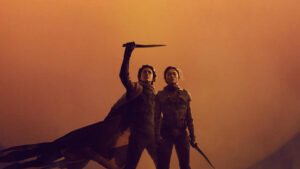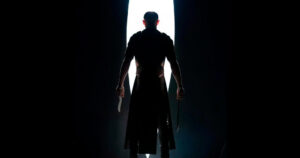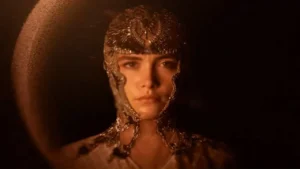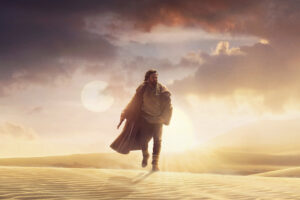Not many people ever watched it, for reasons that should become clear before the end of this sentence, but way back in February 2015, late at night and without any advertising, Winter Dragon, a roughly half-hour long adaptation of the prologue of Robert Jordan’s The Eye Of The World starring The Price Is Right‘s Max Ryan as Lews Therin Telamon, and Wheel Of Time super-fan Billy Zane of Titanic fame as the Forsaken Ishamael, aired on the FXX Network. I have seen it. It is not good. But the bizarre short film was never really intended to attract a sizable audience, or even appeal to fans. It was self-produced by Red Eagle Entertainment (or Manetheren LLC, or Ree Productions…they change their name every few years), a company cofounded by Rick Selvage and Larry Mondragon in 2003, which had bought the film and television rights to The Wheel Of Time from Jordan in 2004, sold them to Universal in 2008, got them back when Universal decided not to move forward with a film adaptation of The Eye Of The World, and then sat on them until the year that the rights were set to revert back to Jordan’s estate, at which point they frantically put together Winter Dragon for the sole purpose of preventing that from happening.

Soon thereafter, Jordan’s widow Harriet McDougal voiced her frustration with Red Eagle Entertainment, and they took the very smart and rational approach of suing her for slander. Though the legal battle was not long, and directly resulted in the joint announcement of the Wheel Of Time television adaptation from Amazon Studios which this year released its critically-acclaimed second season, the fandom has not forgotten or forgiven Red Eagle Entertainment for their underhanded methods, and the prevailing attitude towards them and all of their independent ventures ranges from mild bemusement to open disdain. But that hasn’t stopped Red Eagle Entertainment, or should I say “iwot Productions” as it was renamed (again) in 2021, from trying to get several of their own projects off the ground, with…uh, varying degrees of un-success.
Just in the past two years, iwot has announced (1) a trilogy of live-action films set long before the events of the book and television series during the fabled Age of Legends, to be written by Zack Stentz and executive produced by Eva Longoria, (2) an animated film centered around the White Tower, to be written and produced by Zack Stentz and directed by Jay Oliva, best known for Justice League: War, and (3) most recently, an “immersive adaptation” of the books that will use “360-degree visuals and sound, holographic projections, and spatial storytelling, to create a riveting entertainment experience”…whatever the heck that means. Nothing in iwot’s history suggests that any one of these projects will ever make it past the indefinite pre-production stage in which they’re all currently stalled, but the most ambitious, the live-action film tentatively titled The Age Of Legends and intended to kickstart a trilogy, now has a director attached.
And Kari Skogland, who previously directed all six episodes of The Falcon And The Winter Soldier, as well as episodes of The Handmaid’s Tale and The Walking Dead, is not exactly nobody. That’s not to say she can magically save iwot from their own proven ineptitude, or make something great from a Zack Stentz script (X-Men: First Class is considered some of his better work, and the first Thor movie is an example of his worst), but I know I can trust Skogland to tackle the intricate philosophy of Jordan’s invented cosmos, dive into the dark complexities of his painfully human heroes and villains, and bring us some awesome action sequences using the mechanics of the One Power to the fullest extent. If this were being produced by anyone else, I might actually be excited.

If you’re new around here or in need of a refresher, The Wheel Of Time is set in a world, technically our world, in which time literally forms a loop, meaning that history endlessly cycles back around on itself in what is referred to as a “Turning”. Every Turning may not be the same length, but they are all divided up into seven Ages, and a new Turning begins when the Seventh Age ends. Every Turning is different, too, sometimes only slightly, sometimes dramatically, but there are certain consistencies across time. The First Age is this one, the modern world in which we live, and it is always followed by the Second Age or Age of Legends, the almost utopian sci-fi fantasy world in which the One Power is rediscovered and one half of it tainted by the Dark One, and that event is probably always followed by the Breaking of the World, which leads into the Third Age, the fantasy world into which the Dragon is eventually reborn to defeat the Dark One.
In the Turning during which Jordan’s books take place, the end of the Age of Legends is presaged by the Drilling of the Bore, when a physicist and Aes Sedai named Mierin Eronaile opens a rift in reality that allows the Dark One, who has been caged outside the universe since the Moment of Creation, to seep into the world. Mierin, later known by the name Lanfear, becomes the first of many powerful Aes Sedai to join the Dark One in his mission to break the Wheel of Time itself. The thirteen most powerful of these ambassadors are named the Forsaken, and their ranks include representatives of every field, from philosophers, surgeons, and military historians, to athletes, singers, and psychiatrists. Their tragic tales could each be spun into compelling and dramatic feature-length stories.

The question that a lot of fans are asking is whether the film trilogy will aim for some semblance of continuity with the Amazon series, or whether iwot will try to establish their own competitive aesthetic for the world of The Wheel Of Time. Depending on which approach they take, iwot might approach Natasha O’Keeffe, Fares Fares, and Alexander Karim to reprise their roles as Lanfear, Ishamael, and Lews Therin Telamon, respectively, though I have a gut feeling that will not happen, and that they will instead try to hitch some unsuspecting high-profile Hollywood actor to this project next. But let’s cross that bridge when we come to it. We don’t even know if they’ll make it that far. Here’s hoping, though. I’d genuinely love to see Wheel Of Time enter the mainstream in a way it still hasn’t quite been able to, even after fifteen best-selling books and two fantastic seasons of television. Maybe a film trilogy is what it takes. But Winter Dragon, the only thing that iwot (or Red Eagle Entertainment or whatever you wanna call them) has ever released on their own, doesn’t inspire much confidence.
How about you? Are you excited for The Age Of Legends? Does Skogland boarding the subject actually make it any more likely that this thing ever gets made? Share your own thoughts, theories, and opinions, in the comments below!








